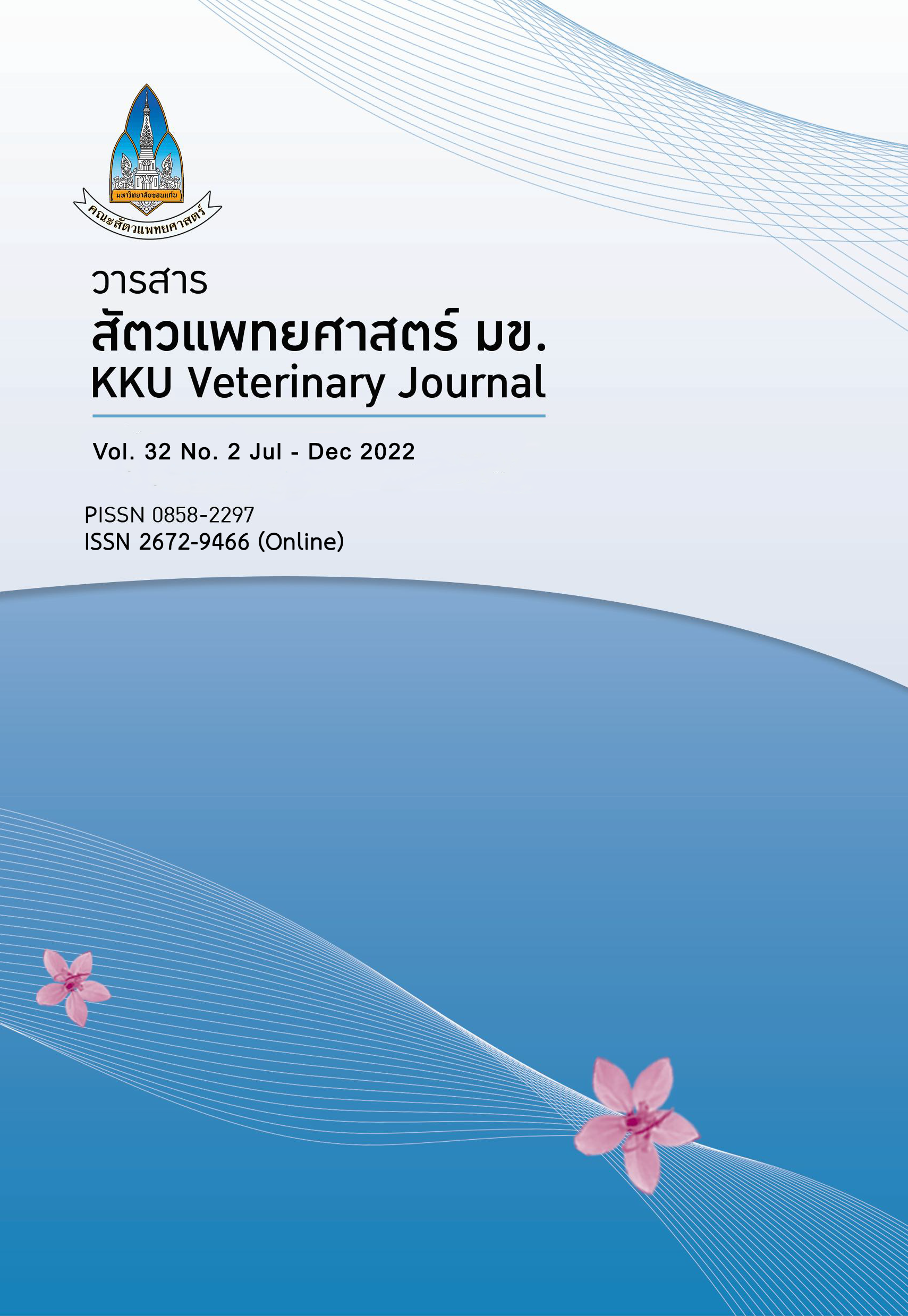การสะสมทางชีวภาพของสารหนู ตะกั่ว และแคดเมียมของปลานิล น้ำ และตะกอนดินจากบ่อรวบรวมน้ำบริเวณแหล่งกำจัดขยะของเทศบาลนครขอนแก่น
Main Article Content
บทคัดย่อ
บทนำ การปนเปื้อนของโลหะหนักในสิ่งแวดล้อมอาจเกิดได้จากการกำจัดขยะที่ไม่มีประสิทธิภาพเพียงพอ
วัตถุประสงค์ เพื่อหาปริมาณการสะสมของสารหนู ตะกั่ว และแคดเมียมในปลานิล (Oreochromis niloticus) ที่อาศัยในบ่อรวบรวมน้ำที่อยู่ในแหล่งกำจัดขยะของเทศบาลนครขอนแก่น และการวัดค่าสะสมทางชีวภาพในปลา
วัสดุ อุปกรณ์ และวิธีการ เก็บตัวอย่างน้ำและตะกอนดินจากบ่อรวบรวมน้ำในแหล่งกำจัดขยะของเทศบาลนครขอนแก่น จำนวนชนิดละ 10 ตัวอย่าง และตัวอย่างปลานิลที่อาศัยในบ่อจำนวน 30 ตัว โดยเก็บชิ้นส่วนแยกเป็นกล้ามเนื้อ เหงือก และตับของปลา เพื่อวิเคราะห์หาปริมาณโลหะหนักตามวิธีมาตรฐานและประเมินค่าการสะสมทางชีวภาพ
ผลการศึกษา ปริมาณของสารหนู ตะกั่ว และแคดเมียมในน้ำมีค่าเฉลี่ย 0.016±0.004, 0.032±0.004 และ 0.009±0.003 mg/l ตามลำดับ ปริมาณที่พบในตะกอนดินมีค่าเฉลี่ย 49.767±6.309, 86.663±4.321 และ 20.474±3.616 mg/kg ตามลำดับ ตัวอย่างน้ำและตะกอนดินทั้งหมดมีค่าสารหนูสูงเกินกว่าค่ามาตรฐานที่กำหนดโดยคณะกรรมการสิ่งแวดล้อมแห่งชาติ ค่าเฉลี่ยของสารหนู ตะกั่ว และแคดเมียมที่สะสมในกล้ามเนื้อปลานิลมีค่า 0.067±0.135, 0.078±0.173 และ 0.040±0.102 mg/kg ตามลำดับ เมื่อเปรียบเทียบปริมาณโลหะหนักระหว่างกล้ามเนื้อ เหงือก และตับปลา พบว่ามีความแตกต่างอย่างมีนัยสำคัญทั้งสามชนิดของโลหะหนัก (P<0.05 ทุกชนิด) ค่าการสะสมทางชีวภาพในกล้ามเนื้อปลามีค่า 4.08, 2.44 และ 4.43 สำหรับสารหนู ตะกั่ว และแคดเมียมตามลำดับ สัดส่วนของปลาที่มีค่าตะกั่วในกล้ามเนื้อเกินกว่าค่าสูงสุดที่กำหนดโดยสำนักงานมาตรฐานสินค้าเกษตรและอาหารแห่งชาติ คิดเป็นร้อยละ 10
สรุป ปลานิลที่อาศัยในบ่อรวบรวมน้ำบริเวณแหล่งกำจัดขยะถึงร้อยละ 10 มีค่าปริมาณตะกั่วที่พบในกล้ามเนื้อสูงกว่าค่ามาตรฐานสำหรับอาหาร และปริมาณสารหนูทั้งในน้ำและตะกอนดินทุกตัวอย่างมีค่าสูงกว่าค่ามาตรฐานด้านสิ่งแวดล้อม ผลการศึกษาแสดงถึงอันตรายจากการบริโภคปลานิลที่มาจากสิ่งแวดล้อมที่ปนเปื้อนโลหะหนัก และแสดงถึงเส้นทางการปนเปื้อนของโลหะหนักจากแหล่งกำจัดขยะสู่ผู้บริโภคผ่านทางห่วงโซ่อาหาร
Article Details

อนุญาตภายใต้เงื่อนไข Creative Commons Attribution-NonCommercial-NoDerivatives 4.0 International License.
เอกสารอ้างอิง
ACFS (National Bureau of Agricultural Commodity and Food Standards). 2006. Thai Agricultural Standard: TAS 9007-2005. Ministry of Agriculture and Cooperatives.
Ahmed ASS, Rahman M, Sultana S, Babu SMOF, Sarker MSI. 2019. Bioaccumulation and heavy metal concentration in tissues of some commercial fishes from the Meghna River Estuary in Bangladesh and human health implications. Mar Pollut Bull 145, 436-447.
ATSDR (Agency for Toxic Substances and Disease Registry). 2022. Substance Priority List. U.S. Department of Health and Human Services. Atlanta, Georgia USA [Cited 2022 Nov 1]. Available from: https://www.atsdr.cdc.gov/spl/index.html#2022spl
Crookes M, Brooke Dave. 2011. Estimation of fish bioconcentration factor (BCF) from depuration data. Environment Agency, Horizon House, Bristol, UK. 230 pp.
Davies OA, Allison ME, Uyi HS. 2009. Bioaccumulation of heavy metals in water, sediment and periwinkle (Tympanotonus fuscatus var radula) from the Elechi Creek, Niger Delta. Afr J Biotechnol 5(10), 968-973.
Ferreira NS, Oliveira LHB, Agrelli V, de Oliveira AF, Nogueira ARA, Oliveira A, Gonzalez MH. 2019. Bioaccumulation and acute toxicity of As (III) and As (V) in Nile tilapia (Oreochromis niloticus). Chemosphere 217, 349-354.
Ju YR, Chen CW, Chen CF, Chuang XY, Dong CD. 2017 Assessment of heavy metals in aquaculture fishes collected from southwest coast of Taiwan and human consumption risk. Int Biodeterior Biodegradation 124, 314-325.
Kakar A, Hayat MT, Abbasi AM, Pervez A, Mahmood Q, Farooq U, Akbar TA, Ali S, Rizwan M, El-Serehy HA, Abdel-Daim MM. 2020. Risk Assessment of Heavy Metals in Selected Marine Fish Species of Gadani Shipbreaking Area and Pakistan. Animals (Basel) 10(10), 1738. https://doi.org/10.3390/ani10101738
Licata P, Trombetta D, Cristani M, Naccari C, Martino D, Calo M., Naccari F. 2005. Heavy Metals in Liver and Muscle of Bluefin Tuna (Thunnus thynnus) Caught in the Straits of Messina (Sicily, Italy). Environ Monit Assess 107, 239–248.
Ministry of Natural Resources and Environment. 1994. Announcement of National Environment Committee No. 8. Standard level on water surface quality. [In Thai]
Ministry of Natural Resources and Environment. 2004. Announcement of National Environment Committee No. 25. Standard level on soil quality. [In Thai]
Ministry of Public Health. 2020. Notification No 414 B.E. 2563. Standards for Contaminants in Food [In Thai].
Public Relations Department Region 1. 2018. General Public Information. The Government Public Relations Department, Thailand. [Cited 2019 May 21] Available from: https://region1.prd.go.th/th/content/category/index/id/9
Pyle GG, Rajotte JW, Couture P. 2005. Effects of industrial metals on wild fish populations along a metal contamination gradient. Ecotoxicol Environ Saf 61(3), 287-312.
Rajeshkumar S, Li X. 2018. Bioaccumulation of heavy metals in fish species from the Meiliang Bay, Taihu Lake, China. Toxicol Rep 19(5), 288-295.
Sungsitthisawad W, Nienvitoon T, Inmuang U, Thiramanus T. 1999. Bioaccumulation of heavy metals in Aquatic Biota from Khon Kaen City wasterwater treatment system. KKU Research J 4(2), 63-73.
Tanee T, Punsombut P, Chaveerach A, Sudmoon R, Saowakoon S. 2017. Bioaccumulation of heavy metals in water, sediment and fish from Mun river. J Fish Tech Res 11(1), 82-92.


